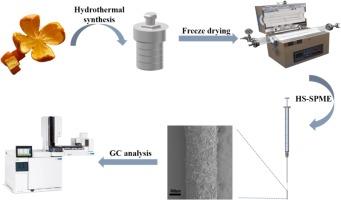Headspace solid-phase microextraction using a Citrus reticulata peel carbon aerogel for gas chromatography quantification of organochlorine pesticides in fruit and vegetable samples
IF 4.9
2区 化学
Q1 CHEMISTRY, ANALYTICAL
引用次数: 0
Abstract
A headspace solid-phase microextraction (HS-SPME) method using Citrus reticulata peel carbon aerogel (CRPCA) combined with gas chromatography (GC) was developed for the detection of organochlorine pesticides (OCPs) in fruit and vegetable samples. CRPCA was synthesized by hydrothermal reaction and carbonization of Citrus reticulata peel. Characterization of CRPCA revealed that it possesses an open porous structure, high thermal stability, and abundant functional groups. Experimental parameters for the adsorption and desorption of OCPs using CRPCA-coated fiber were optimized. Under optimal conditions, the developed method showed good linearity in the range of 0.1 to 10ng/g (r2 ≥ 0.991), low detection limits (0.002–0.052ng/g), and high reusability (100 cycles). The HS-SPME-GC method using CRPCA-coated fiber was applied to real samples (Chinese cabbage, white radish, apple, peach, and pear). The established method enables the simple, environmentally friendly, and sensitive detection of trace OCPs in complex matrices.

利用柑橘果皮碳气凝胶进行顶空固相微萃取,以气相色谱法定量检测水果和蔬菜样品中的有机氯农药含量
利用柑橘类果皮碳气凝胶(CRPCA)结合气相色谱法(GC)开发了一种顶空固相微萃取(HS-SPME)方法,用于检测水果和蔬菜样品中的有机氯农药(OCPs)。CRPCA 是通过水热反应和柑橘皮碳化合成的。对 CRPCA 的表征表明,它具有开放的多孔结构、高热稳定性和丰富的官能团。对使用 CRPCA 涂层纤维吸附和解吸 OCPs 的实验参数进行了优化。在最佳条件下,所建立的方法在0.1~10ng/g范围内线性关系良好(r2 ≥ 0.991),检出限低(0.002~0.052ng/g),重复使用率高(100次)。将 CRPCA 涂层纤维的 HS-SPME-GC 方法应用于实际样品(大白菜、白萝卜、苹果、桃和梨)。所建立的方法能够简单、环保、灵敏地检测复杂基质中的痕量 OCP。
本文章由计算机程序翻译,如有差异,请以英文原文为准。
求助全文
约1分钟内获得全文
求助全文
来源期刊

Microchemical Journal
化学-分析化学
CiteScore
8.70
自引率
8.30%
发文量
1131
审稿时长
1.9 months
期刊介绍:
The Microchemical Journal is a peer reviewed journal devoted to all aspects and phases of analytical chemistry and chemical analysis. The Microchemical Journal publishes articles which are at the forefront of modern analytical chemistry and cover innovations in the techniques to the finest possible limits. This includes fundamental aspects, instrumentation, new developments, innovative and novel methods and applications including environmental and clinical field.
Traditional classical analytical methods such as spectrophotometry and titrimetry as well as established instrumentation methods such as flame and graphite furnace atomic absorption spectrometry, gas chromatography, and modified glassy or carbon electrode electrochemical methods will be considered, provided they show significant improvements and novelty compared to the established methods.
 求助内容:
求助内容: 应助结果提醒方式:
应助结果提醒方式:


